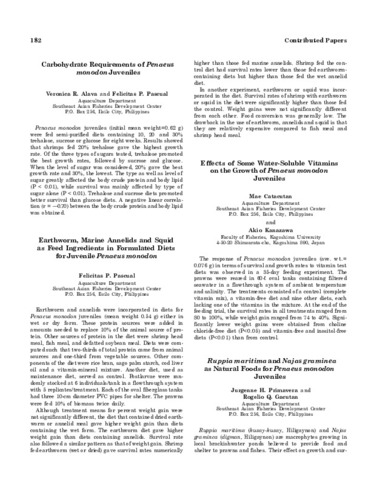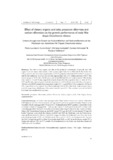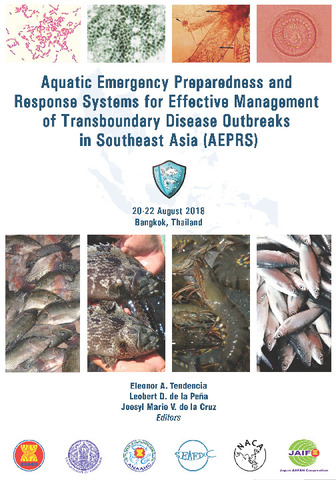Laboratory manipulation of Gracilariopsis bailinae Zhang et Xia (Gracilariales, Rhodophyta)
| dc.contributor.author | Rabanal, S. F. | |
| dc.contributor.author | Azanza, R. | |
| dc.contributor.author | Hurtado-Ponce, A. | |
| dc.date.accessioned | 2013-04-22T07:44:54Z | |
| dc.date.available | 2013-04-22T07:44:54Z | |
| dc.date.issued | 1997 | |
| dc.identifier.citation | Rabanal, S. F., Azanza, R., & Hurtado-Ponce, A. (1997). Laboratory manipulation of Gracilariopsis bailinae Zhang et Xia (Gracilariales, Rhodophyta). Botanica Marina, 40(1-6), 547–556. | en |
| dc.identifier.issn | 0006-8055 | |
| dc.identifier.uri | http://hdl.handle.net/10862/1600 | |
| dc.description.abstract | Carpospore germination, carposporeling development and tetraspore formation were investigated in Gracilariopsis bailinae Zhang et Xia by manipulating photoperiod, photon flux density, temperature, salinity and nutrients. Laboratory-generated sporelings attained mean growth rate from 4.05 to 10.31% d-1 during the first week of incubation. Duncan s multiple range test (DMRT) showed that growth rates were significantly different (P < 0.05) between the treatment combinations and between weekly intervals. The optimal condition for growth of sporelings, irrespective of culture age, was attained at treatment combinations of 26°C, 11:13 (h. L:D) photoperiod, 100 µEm-2s-1 photon flux density (PFD), 25 µM NH4Cl: 2.5 µM K2HPO4 and 25ppt salinity followed by a treatment combination of 26°C, 11:13 (h. L:D) photoperiod, 100 µEm-2s-1 photon flux density (PFD), 50 µM NH4Cl: 5 µM K2HPO4 and 25 ppt salinity. For the first time in this species, tetraspore formation was induced in the laboratory. The tetrasporophyte produced many tetraspores in almost all branches of the thallus grown at 26°C, 11:13 (h. L:D) photoperiod, 100 µEm-2 s-1, 25 µM NH4Cl: 2.5 µM K2HPO4 and at 30 ppt salinity while those grown at lower light, higher nutrient level and higher salinity had fewer tetraspores. No tetraspores were formed at a higher temperature (30°C), longer photoperiod (13:11 h. L:D), and at 25 ppt salinity and the plants remained vegetative from 4 to 7 months. Logistic regression analysis showed that tetrasporangial induction was significantly affected by nutrients and salinity (P < 0.05). | en |
| dc.language.iso | en | en |
| dc.publisher | Walter de Gruyter | en |
| dc.title | Laboratory manipulation of Gracilariopsis bailinae Zhang et Xia (Gracilariales, Rhodophyta) | en |
| dc.type | Article | en |
| dc.identifier.doi | 10.1515/botm.1997.40.1-6.547 | |
| dc.citation.volume | 40 | |
| dc.citation.issue | 1-6 | |
| dc.citation.spage | 547 | |
| dc.citation.epage | 556 | |
| dc.citation.journalTitle | Botanica Marina | en |
| seafdecaqd.library.callnumber | VF SJ 0550 | |
| seafdecaqd.databank.controlnumber | 1997-22 | |
| dc.subject.asfa | algal culture | en |
| dc.subject.asfa | alternate reproduction | en |
| dc.subject.asfa | light effects | en |
| dc.subject.asfa | mineral nutrients | en |
| dc.subject.asfa | salinity effects | en |
| dc.subject.asfa | seaweeds | en |
| dc.subject.asfa | temperature effects | en |
| dc.subject.asfa | asexual reproduction | en |
| dc.subject.scientificName | Gracilariopsis heteroclada | en |
このアイテムのファイル
| ファイル | サイズ | フォーマット | 閲覧 |
|---|---|---|---|
|
このアイテムに関連するファイルは存在しません。 |
|||
このアイテムは次のコレクションに所属しています
-
Journal Articles [1258]
These papers were contributed by Department staff to various national and international journals.



